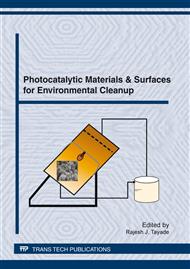[1]
J. M. Herrmann, Heterogeneous photocatalysis: fundamentals and applications to the removal of various types of aqueous pollutants, Catalysis Today 53 (1999) 115-129.
DOI: 10.1016/s0920-5861(99)00107-8
Google Scholar
[2]
D. M. Blake, Bibliography of Work on the Heterogeneous Photocatalytic Removal of Hazardous Compounds from Water and Air, NREL/TP- 570-26797. National Renewable Energy Laboratory, Golden CO, (1999).
DOI: 10.2172/12101
Google Scholar
[3]
A. A. Adesina, Industrial exploitation of photocatalysis: Progress, perspectives and prospects. Catalysis Surveys from Asia, 8 (2004) 265-273.
DOI: 10.1007/s10563-004-9117-0
Google Scholar
[4]
R. L. Pozzo, M. A. Baltanas, A. E. Cassano, Supported titanium dioxide as photocatalysy in water decontamination: State-of-art, Catalysis Today 39 (1997) 219-231.
DOI: 10.1016/s0920-5861(97)00103-x
Google Scholar
[5]
F. Sunada, A. Heller, Effects of water, salt water and silicone over coating of the TiO2 photocatalyst on the rates and products of photocatalytic oxidation of liquid 3-octanol and and 3-Octanone. Environ. Sci. Technol., 32 (1998) 282-286.
DOI: 10.1021/es970523f
Google Scholar
[6]
A. Blazkova, L. Karpinsky, J. Groskova, B. Havlinova, V. Jorik, M. Ceppan, Phenol decomposition using Mn+/TiO2 photo catalyst supported by the sol-gel technique on glass fibres. J. Photochem. Photobiol., 109 (1997)177-183.
DOI: 10.1016/s1010-6030(97)00121-4
Google Scholar
[7]
R. W. Matthews, Photooxidative degradation of colored organics in water using supported catalysts. TiO2 on sand, Water Res. 25 (1991)1169-1176.
DOI: 10.1016/0043-1354(91)90054-t
Google Scholar
[8]
A. Fernandez, G. Lasaletta, V. M. Jimenez, A. Justo, A.R. Gonzallez-Elipe, J.M. Herrmann, H. Tahiri, Y. Ait-Ichou, Preparation and characterization of TiO2 photo catalyst supported on various rigid supports (glass, quartz and stainless steel). Comparative studies of photocatalytic activity in water purification, Appl. Catal B: Environ. 7 (1995).
DOI: 10.1002/chin.199614030
Google Scholar
[9]
N. Takeda, N. Iwatta, T. Torinoto, H. Yoneyama, Influence of carbon black as an adsorbent used in TiO2 photocatalyst films on photodegradation behaviour of propyzamide, J. Catal. 177 (1998) 240-246.
DOI: 10.1006/jcat.1998.2117
Google Scholar
[10]
N. N. Rao, S. Dube, Application of Indian commercial TiO2 powder for destruction of organic pollutants. Photocatalytic degradation of 2, 4-dichlorophenoxy aceticacid (2, 4-D) using suspended and supported TiO2 catalysts, Ind. J. Chem. Technol. 2(1995).
Google Scholar
[11]
J. Sheng, J. Karasawa, T. Fukami, Thickness Dependence of Photocatalytic Activity of Anatase Film by Magnetron Sputtering, J. Mater. Sci. Lett., 16(21) (1997)1709–1711.
Google Scholar
[12]
Y. A. Cao, X. T. Zhang, L. Q. Chong, D. Y. Wang, T. F. Xie, Y. Huang, Z. F. Cui, W. G. Shi, X. J. Liu, Z. Y. Wu, Y. B. Bai, T. J. Li, Y. Wu, A Novel TiO2 Film Catalyst - Preparation, Properties and Research on Its Photocatalytic Activity, Mater. Res. Soc. Symp. Proc. 497, Recent Advances in Catalytic Materials, (1998).
DOI: 10.1557/proc-497-79
Google Scholar
[13]
T. Moriya, M. Tatsushi, Y. Hideo, Formation of Titania Fine Particle Layer by Hybrid Process of SPCP-CVD and EFCM for Photocatalytic Reactor, World Congr. Part. Technol. 3, Rugby, UK, Institution of Chemical Engineers: (1998), p.1684–1692.
Google Scholar
[14]
E. Szalkowska, J. Gluszek, J. Masalski, W. Tylus, Structure and Protective Properties of TiO2 Coatings Obtained using the Sol-gel Technique, J. Mater. Sci. Lett., 20(6) (2001) 495-497.
DOI: 10.1023/a:1010955811871
Google Scholar
[15]
N. Nageswara Rao, Priyanka Joshi, Cellulose reinforced-TiO2 photocatalyst coating on acrylic plastic for degradation of reactive dyes, J. Coat. Technol. Res. 7 (2010) 643-650.
DOI: 10.1007/s11998-010-9244-7
Google Scholar
[16]
H. Matsubara, M. Takada, S. Koyama, K. Hashimoto, A. Fujishima, Photoactive TiO2 Containing Paper: Preparation and its Photocatalytic Activity under Weak UV Light Illumination, Chem. Lett., 24 (1995)767-768.
DOI: 10.1246/cl.1995.767
Google Scholar
[17]
Y. Iguchi, H. Ichiura, T. Kitaoka, H. Tanaka, Preparation and Characteristics of High Performance Paper Containing Titanium Dioxide Photocatalyst Supported on Inorganic Fiber Matrix, Chemosphere, 53 (2003)1193-1199.
DOI: 10.1016/s0045-6535(03)00582-4
Google Scholar
[18]
A. Aguedach, S. Brosillon, J. Morvan, E.K. Lhadi, Photocatalytic Degradation of Azo-dyes Reactive Black 5 and Reactive Yellow 145 in Water Over a Newly Deposited Titanium Dioxide, Appl. Catal., B 57 (2005) 55-62.
DOI: 10.1016/j.apcatb.2004.10.009
Google Scholar
[19]
R. Pelton, X. Geng, M. Brook, Photocatalytic Paper from Colloidal TiO2-Fact or Fantasy, Adv. Colloid Interface Sci., 127 (2006) 43–53.
DOI: 10.1016/j.cis.2006.08.002
Google Scholar
[20]
Z. Liuxue, W. Xiulian, L. Peng, S. Zhixing, Photocatalytic Activity of Anatase Thin Films Coated Cotton Fibers Prepared via a Microwave Assisted Liquid Phase Deposition Process, Surf. Coat. Technol., 201 (2007) 7607-7614.
DOI: 10.1016/j.surfcoat.2007.02.004
Google Scholar
[21]
M. J. Uddin, F. Cesano, S. Bordiga, G. Spoto, D. Scarano, A. Zecchina, A, Photoactive TiO2 films on Cellulose Fibers: Synthesis and Characterization, J. Photochem. Photobiol., A 189 (2007) 286-294.
DOI: 10.1016/j.jphotochem.2007.02.015
Google Scholar


